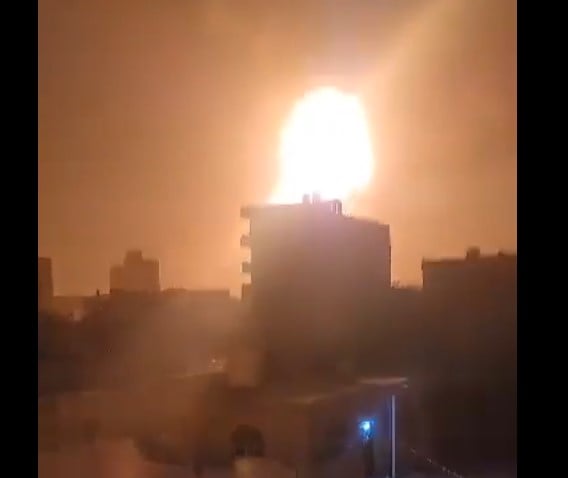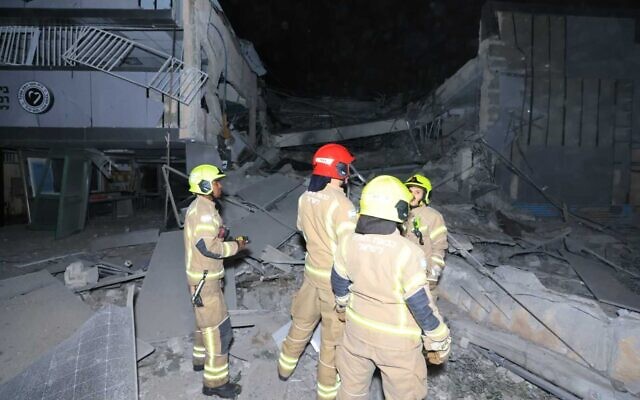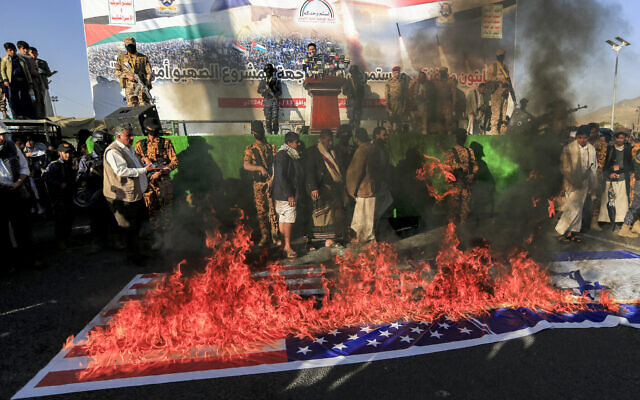



The Israeli military carried out a series of intense airstrikes that shook Yemen’s rebel-held capital and a port city early Thursday, in a pre-planned operation that coincided with the Houthis firing a missile at central Israel.
No one was injured by the ballistic missile, which the Israel Defense Forces said was downed outside Israeli airspace by the long-range Arrow air defense system, though falling shrapnel caused heavy damage in the city of Ramat Gan. It was the second missile from Yemen fired this week, along with a drone attack.
According to a statement by the Israel Defense Force, dozens of Israeli Air Force (IAF) aircraft participated in the strikes in Yemen — conducted shortly after the missile launch –including fighter jets, refuelers and spy planes, some 2,000 kilometers from Israel. The Houthi “military targets” were struck at the Hodeidah port — which Israel has struck twice before — and for the first time, in the rebel-held capital Sana’a, the IDF said.
Planes hit tugboats used to bring ships into the port and power stations in the capital.
The IAF had been preparing for the strike for several weeks, military sources said, and the planes were already on their way to Yemen when the Houthis launched their missile at Israel.
The projectile set off sirens in central Israel communities due to concerns about falling debris from the interception, which caused extensive damage to a school in Ramat Gan, where a building collapsed. Millions of people were forced into bomb shelters due to the attack, the IDF said.
The military was investigating the incident. In the past, partially intercepted missiles launched at Israel have crashed with their warhead intact and caused extensive damage.
The shrapnel also struck a number of parked cars in the city, which is a suburb of Tel Aviv.
The Houthis did not immediately claim the missile attack but said an important military statement would be issued in the coming hours, following a pattern of how they claim their assaults.
Israeli military sources said the strikes in Yemen were aimed at paralyzing all three ports used by the Iran-backed Houthis on the coast of the country.
All of the tugboats used to bring ships into ports were struck in the Israeli attack.
In Israel’s previous attack on the Hodeida port, the cranes used to unload shipments were struck.
Israel now believes that all activity at the ports controlled by the Houthis is paralyzed, sources said.
Shortly after the missile fire, the Houthi satellite channel al-Masirah reported strikes in Sana’a and the coastal Hodeida province, some of which it said targeted power stations in the capital as well as the Ras Isa oil terminal on the Red Sea.
It said the strikes killed nine people.
Unverified video shared on social media purported to show the aftermath of the attack, showing buildings ablaze.
The overnight airstrikes marked the first time the IDF has hit targets in Sana’a and the third time it has struck Yemen in response to Houthi attacks, including in July following a drone attack that killed a civilian in Tel Aviv.
IDF Spokesman Rear Adm. Daniel Hagari confirmed that among the targets hit in the “precise strikes” were “ports and energy infrastructure,” which he accused the Houthis of harnessing for “their military actions.”
“With their attacks on international shipping vessels and routes in the Red Sea and other places, the Houthis have become a global threat. Who is behind the Houthis? Iran,” he said in an English-language video statement while vowing the military “will act against anyone in the Middle East” who threatens Israel.
The airstrikes on Houthi targets in Yemen overnight were carried out in two waves, according to the military.
Fourteen IAF fighter jets, along with refuelers and spy planes, were involved in the strikes, which had been planned by the military for several weeks in response to the Iran-backed group’s attacks on Israel.
IAF fighter jets were already en route to Yemen when the Houthis launched a ballistic missile at Israel at around 2:35 a.m. The strike was set for overnight due to various operational concerns and efforts to improve intelligence on the targets.
At 3:15 a.m. the first wave of strikes was carried out along the coast of Yemen, hitting the Hodeidah, Ras Isa and Salif ports. Eight tugboats used to bring ships into the ports were also destroyed in the strikes. A second wave of airstrikes at 4:30 a.m. hit two power stations in Sana’a.
In all, dozens of munitions were dropped by the IAF on the five targets, the military said.
The Kan public broadcaster reported that Israel had notified the US before the strike.
Rebel-held Hodeida, some 145 kilometers (90 miles) southwest of Sana’a, has been key for food shipments into Yemen as its decade-long civil war has gone on. There have also long been accusations that weapons from Iran have been transferred through the port — which the IDF referred to in an earlier statement on the strikes.
“Attacking these targets harms the terrorist authorities by preventing the exploitation of infrastructure for military and terror purposes, including transferring Iranian weaponry to the region,” said the IDF statement.
The IDF also said that “with Iran’s guidance and funding,” the Houthis have acted together with Iran-backed militias over the past year to attack Israel, “undermine regional stability and disrupt global shipping.”
“The IDF is determined to continue acting and striking whoever threatens citizens of the State of Israel, at any distance required.”
The Houthis have launched over 200 missiles and 170 drones at Israel in the past year. According to the IDF, the vast majority did not reach Israel or were intercepted by the military and its allies in the region.
Defense Minister Israel Katz issued a warning to Houthi leaders on Thursday.
“The long arm of Israel will reach you,” he said in a statement. “Whoever lifts a hand will have it severed. Whoever strikes [us], will be struck many times over.”
In addition to Israel, American forces have also launched a series of strikes on the Houthis over nearly a year due to Houthi attacks on shipping in the Red Sea corridor. On Monday, the US military’s Central Command said it hit “a key command-and-control facility” operated by the Houthis in Sana’a, later identified as the al-Ardi complex once home to the government’s defense ministry.
The Houthis have targeted some 100 merchant vessels with missiles and drones since its Palestinian ally Hamas’s October 2023 terror onslaught against Israel sparked the ongoing war in Gaza. They have also repeatedly fired missiles and drones at Israel.
On Monday, the Houthis claimed a missile launch they said was aimed at “a military target of the Israeli enemy in the occupied area of Yaffa” — a reference to the Tel Aviv area.
Also Monday, an Israeli navy missile boat intercepted a drone in the Mediterranean after it was launched from Yemen, the military said.
On December 9, a drone claimed by Houthis exploded on the top floor of a residential building in the central Israel city of Yavne, causing no casualties.
In July, a Houthi drone attack in Tel Aviv killed an Israeli civilian, prompting retaliatory strikes on the Yemeni port of Hodeida.
In the Red Sea, the Houthis have seized one vessel and sunk two in a campaign that has also killed four sailors. Other missiles and drones have either been intercepted by separate US- and European-led coalitions in the Red Sea or failed to reach their targets, which have also included Western military vessels.
The rebels maintain that they target ships linked to Israel, the US or the United Kingdom to force an end to Israel’s campaign against Hamas in Gaza. However, many of the ships attacked have little or no connection to the conflict, including some bound for Iran.
The Houthis have battled a Saudi-led coalition into a stalemate in a wider Yemen war that’s killed more than 150,000 people, including civilians. The conflict also has created one of the world’s worst humanitarian disasters that is believed to have killed tens of thousands more.



